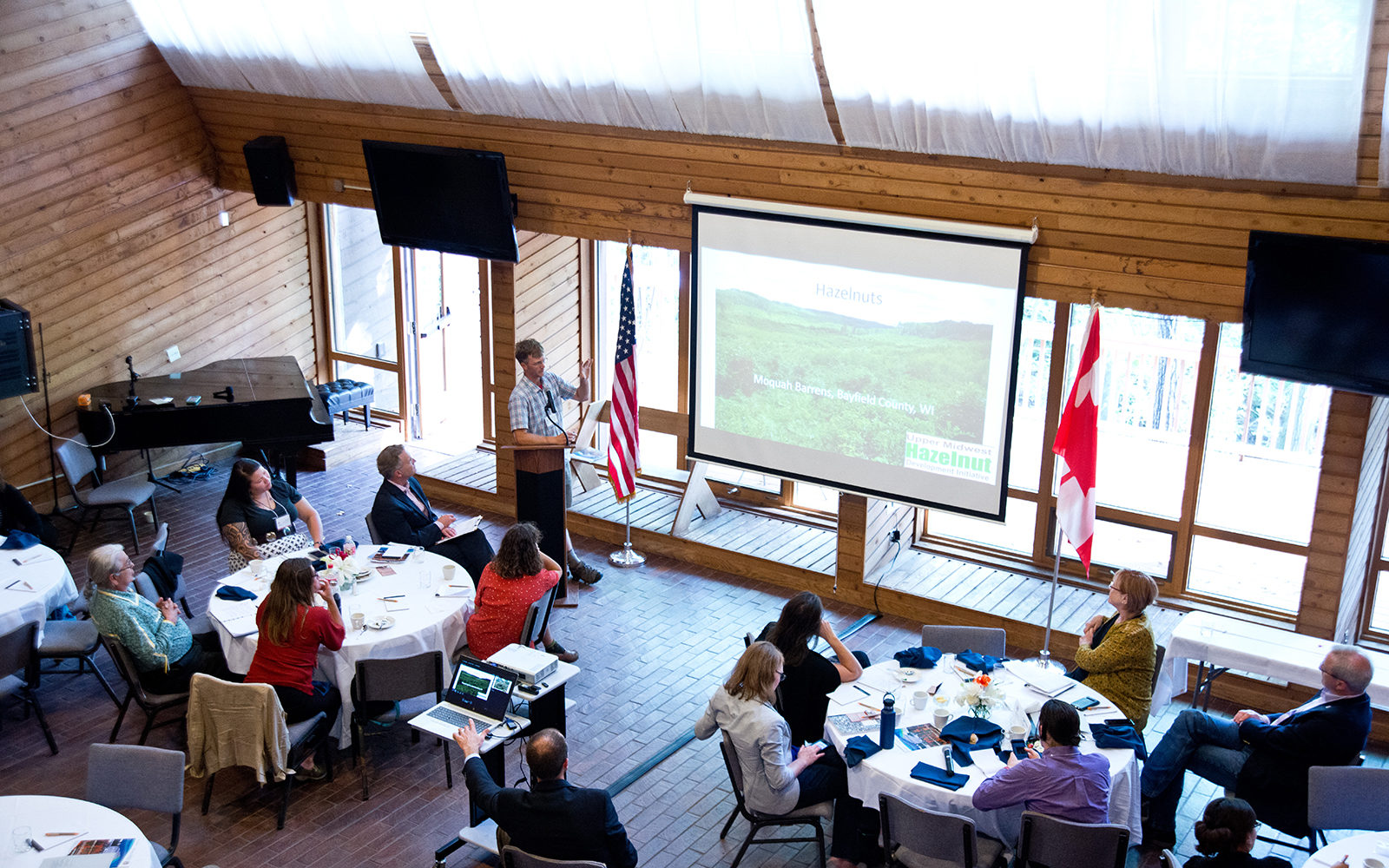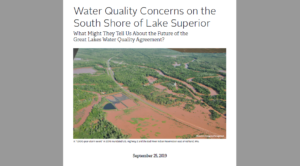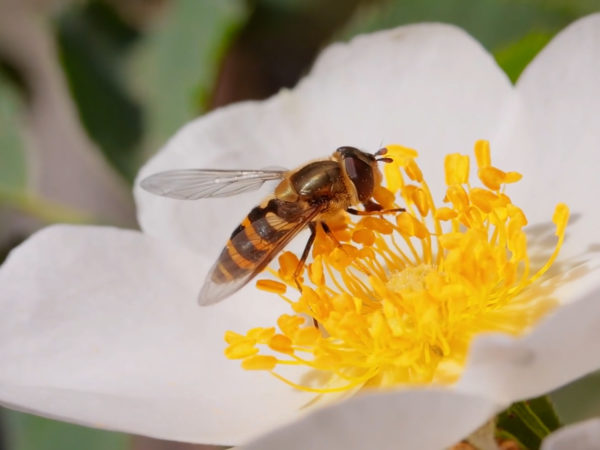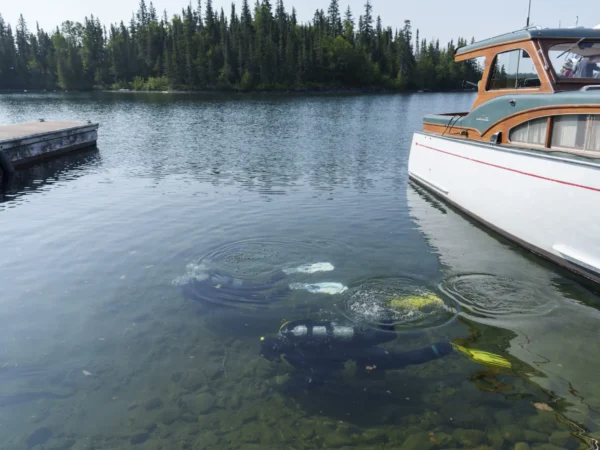
Climate change, storms, algal blooms and funding for infrastructure were among the issues identified by the roughly 200 people who turned out in Ashland, Wisconsin, to tell a group of representatives from the International Joint Commission about their observations about Lake Superior.
Their input contributed to a white paper, published earlier this month, which should help inform the IJC’s progress report, paint a picture of water quality conditions for the public and be a useful tool for local government officials, according to Valerie Damstra, operations manager of the Mary Griggs Burke Center for Freshwater Innovation.
The Ashland event, called “Step In and Speak Out for the Great Lakes: Lake Superior” by the IJC as well as the 2019 Water Summit by the Burke Center, was intended to give the public an opportunity to share their concerns.
“I have done all that I can to protect the water, and it is my hope that all of you will do whatever you can in your power to protect the lake and make sure that it will still be clean, clear and beautiful seven generations from now,” Auggie Walheim, a freshman at Northland College, said during the forum.
The IJC is a collaboration between the U.S. and Canada that handles transboundary issues and makes recommendations to the governments of both countries regarding Great Lakes water issues.

The Mary Griggs Burke Center for Freshwater Innovation and the International Joint Commission held a public forum on Sept. 25, 2019, on Lake Superior water quality. Photo courtesy of Mary Griggs Burke Center for Freshwater Innovation.
The forum in Ashland was just one of a series of roundtables, listening sessions and public meetings the IJC held over the course of this summer and fall to hear the public’s concerns about the lakes. Besides Ashland, the IJC made stops in Thunder Bay, Ontario, and Duluth, Minnesota, among other stops.
The IJC is required to host these public conversations every three years after the U.S. EPA and Environment and Climate Change Canada release their Great Lakes water quality progress report.
“A lot of times at our public meetings it tends to be middle-aged or older folks, so it was great to see that many younger folk at that session” in Ashland, said Sally Cole-Misch, the public affairs officer for the IJC’s Great Lakes office.
The Ashland meeting was held at Northland College and was run by the college’s Burke Center.
“We were using the IJC’s visit as an opportunity to document what we’ve been calling this ‘water quality snapshot-in-time,’ what’s been happening along the south side of Lake Superior with more frequent, more intense storm events and the water quality issues surfacing as a result,” Damstra said.
The Burke Center brought together experts in a variety of fields from the center and from partners to present on Lake Superior issues to the IJC delegation before the public forum in the evening.
“It wasn’t necessarily new information, but it was the first time it was sort of brought together to take one holistic view of what is the condition of this part of Lake Superior,” Damstra said.
“It can spur conversations on how do we become more adaptable to this new normal of extreme events probably related to climate change.”
Among the concerns brought up during the forum from the experts as well as the public were the extreme storm events and unprecedented blue-green algal blooms.
In June 2012 Duluth was hit by a “500-year storm,” followed by a “1,000-year storm” in both July 2016 and June 2018. The three extreme storm events led to property damage, overflows, overwhelming nutrient runoffs and even deaths.
Those storms have also potentially led to algal blooms forming in what is historically the largest, cleanest and coldest of the Great Lakes, three conditions that had allowed Lake Superior to escape the blooms that plague Lake Erie every year.
“We have a sense that it’s related to these intense storm events that are washing excess sediment and nutrients into the lake when they occur,” Damstra said. “We’re getting an influx of nutrients and, with temperatures warming up, it’s creating conditions that we didn’t think were possible, so we’re taking a hard look at what exactly are the right conditions making these occur, so we can look at solutions for that, because we don’t want Lake Superior to become another Lake Erie.”

The Mary Griggs Burke Center for Freshwater Innovation published a white paper on water quality concerns in Lake Superior, based on a public forum held on Sept. 25, 2019.
Another thing the white paper addressed was the IJC’s Great Lakes Water Quality Agreement, a commitment signed by the U.S. and Canada in 1972 to “restore and maintain the chemical, physical, and biological integrity of the Waters of the Great Lakes.”
“The Great Lakes Water Quality Agreement was written 50 years ago, and the issues we were dealing with then are very different from what we’re dealing with now,” Damstra said. “We weren’t thinking about climate change or blue-green algae in the coldest Great Lake.”
One of the recommendations the Burke Center white paper made was for the IJC to revamp the agreement to look at water quality issues in a more holistic way than the GLWQA currently does with separate categories called “annexes.”
“We’re recommending instead of breaking the agreement down into these compartments, how do we write it in a way that recognizes that these are all related and one recommendation could maybe help solve many water quality issues,” Damstra said.
Under the GLWQA, the IJC has to make an assessment report every three years for nine years. This recent set of conversations is the second of three assessments. The next round of conversations, which will be in 2022, also marks the 50th anniversary of the GLWQA.
“After we receive the next progress report in 2022, we and the government will have to see if we have to revise the agreement or change it significantly,” Cole-Misch said. “It’s something we’ve started to consider but we won’t really consider in full until after this next report.”
The IJC just closed an online survey on Nov. 30, but anyone else interested in sharing their concerns about the Great Lakes can check out the IJC website or subscribe to its Great Lakes newsletter.
For individuals who want to get more engaged, Damstra suggested they use the Burke Center’s white paper as a tool to talk to local government officials about allocating resources for more resilient infrastructure.
“We can’t really do anything about the events but what we can do is make sure we’re adapting our infrastructure to be more resilient if these things happen, and the only way that will happen is if the public demands it,” Damstra said.
Featured image: The Mary Griggs Burke Center for Freshwater Innovation and the International Joint Commission held a public forum on Sept. 25, 2019, on Lake Superior water quality. Photo courtesy of Mary Griggs Burke Center for Freshwater Innovation.




